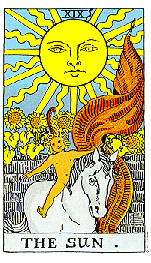

Tarot and Dreams: Interpreting the Symbols of the Soul The Language of Symbols Symbols are a silent and potent language which reaches our conscious awareness through the agency of subconsciousness, rising on wings of spirit from the deepest parts of our being as messengers from our soul. The common denominator of Tarot and dreams is transmission of knowledge and understanding through the agency of subconsciousness and the mechanism of pictorial symbolism. It is a natural marriage to combine Tarot and dreams to deepen and enhance the understanding of dream symbols and to expand our understanding of Tarot.
Dream Power Heeding messages in dreams has a history which stretches back in time at least five thousand years to ancient Egypt and Sumer. Three thousand years ago the authors of the Upanishads, Hindu sacred texts, described dreaming as a higher state of consciousness than the waking state. Dreams might be viewed as a one-way mirror, reflecting a deeper reality behind the seemingly mirrored wall of waking existence. Only by going behind the "mirror" can we perceive differently. Australian Aborigines refer to "the Dreamtime," a sacred state when the soul journeys in the heavenly realms. Through concentration and breathing Aboriginal shamans claim to enter Dreamtime at will, performing consciously in this state while awake. Tibetans have a long tradition of valuing and working with symbolic dream messages. Chuang Tzu, a Taoist seer, wondered with Shakespeare, if "all life was but a dream." Assurbanipal, an Assyrian king from the seventh century B.C.E., considered dream elements to be like ciphers, symbols with distinct meaning. Tutmosis IV of Ancient Egypt Beneath the paws of the Great Sphinx of Egypt is a stone monument called the stela of the dream. This relic is dated to the time of King Tutmosis IV, a New Kingdom Pharaoh who ruled nearly 2,500 years ago. The stela tells a fascinating story. When Tutmosis was a young boy the Sphinx was covered to its neck with sand. One day, in the heat of the desert afternoon, the young prince slept in the shadow of the huge head and had a riveting dream. The Sphinx spoke to Tutmosis in his dream saying, "Son, cast your eyes upon me. Can you see how long I have been neglected? Deliver me from the sands of ages, and I will crown you king of Upper and Lower Egypt." Compelled by the voice in his dream, the prince awoke and ordered workers to free the massive statue from the tons of sand surrounding its enormous body. Tutmosis was soon crowned Pharaoh. He inscribed the stela of the dream and placed the stone between the leonine paws of the Great Sphinx where it remains today.
Tarot and Dreams: Interpreting the Symbols of the Soul.















0 comments